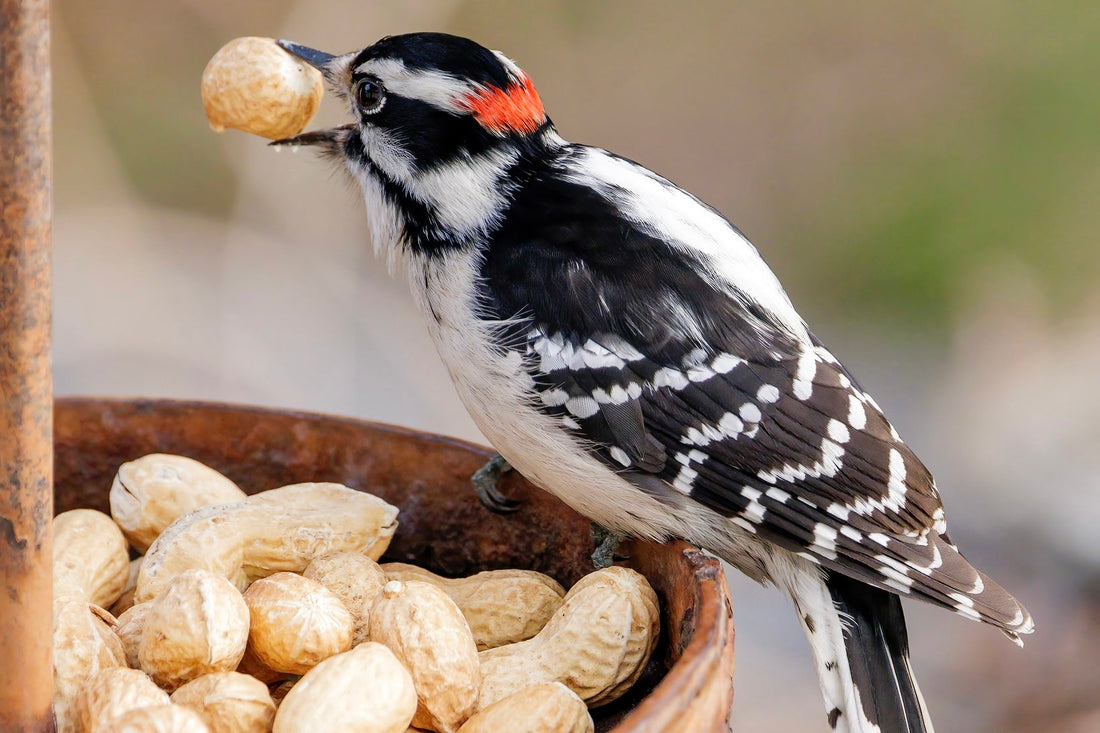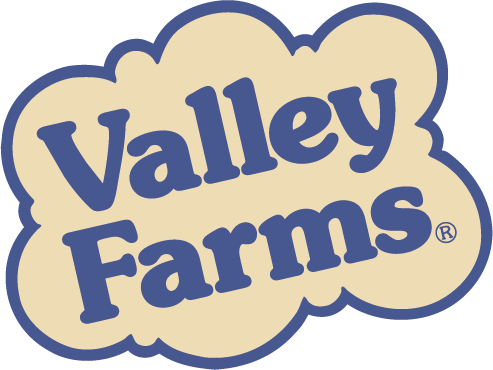
A Passion for Peanuts
Share
Which birds eat them, why they love them, and why peanuts are so good for our flying

A Blue Jay with a whole peanut
Have you noticed that some wild birds have an affinity for peanuts? No, it’s not just you who loves these savory, crunchy legumes. Peanuts are actually a vital component of many wild birds’ diets. High-energy and delicious, peanuts are a go-to for many wild bird species. Read on to learn which birds go nuts for peanuts, why they love them so much, and the different types of peanuts birds may eat.
Why Do Birds Love Peanuts?
What’s not to love about peanuts? Nutritious and high in fat, peanuts are delicious and compact. Protein encompasses up to 30% of the calories in peanuts, making them an excellent source of energy. They also contain vital vitamins, minerals, fiber, and oil, all of which are crucial for keeping the birds nourished in flight and warm during chilly winter nights. Peanut kernels' rich fat and protein keep them zipping around, chirping cheerfully, and looking fabulous. Best of all, peanuts are the perfect food for birds to store as snacks for another day.

A Grackle grappling a large peanut
Which Birds Eat Peanuts?
Did you know that different bird species have their own favorites when it comes to food? Peanut kernels tend to be a crowd-pleaser! Once you start offering them at your feeder, you’ll likely attract a delightful variety of birds. Some of the most enthusiastic fans of peanut kernels will have you smiling as they visit!
Blue Jays: Known for their bold and intelligent nature, Blue Jays will eagerly snatch up peanuts. These birds are also great at keeping an eye out for predators, such as hawks, and their presence around your feeder could offer some added protection for smaller birds.
Woodpeckers: From the Downy to the Red-bellied, woodpeckers adore peanuts, especially when offered in a mesh feeder. Their natural acrobatics allow them to cling to the feeder while easily chipping away at peanut kernels with their strong beaks, making them a top choice for these birds.
Chickadees: Small but mighty, chickadees are energetic birds that love the challenge of cracking open peanut. Despite their small size, they can make quick work of these nutritious treats.
Titmice: Though not named after mice, the tufted titmouse is small, lighting fast, and awfully mouse-like. These lively birds are frequent visitors to feeders offering peanut kernels and are known for their fly-by feeding habits.
Nuthatches: With a loud cackling call, nuthatches are agile birds that love peanuts and often grab one to stash away for later. Watch them scuttle down trees upside down to snag a snack. For a special treat, consider offering nuthatches peanut blend suet.
Juncos: Associated with the snow, Juncos are a gray member of the sparrow family that migrate to the United States during the winter months. Though known for foraging on the ground, juncos will readily consume peanut kernels, adding them to their varied diet.
Offering peanut kernels can turn your yard into a hotspot for bird activity, giving you a front-row seat to some of nature’s most delightful creatures.
While many types of birds will flock to your bird feeder filled with Peanuts, there are some birds that tend to steer clear of them. Hummingbirds, small Finches, and other very small songbirds may avoid peanuts because of their size.

A Black-capped chickadee eating peanuts from a Brome Squirrel Buster Peanut Feeder
What Bird Feeders are Best for Peanuts?
Selecting the appropriate feeder for peanuts for birds is essential for success. Peanuts are easily one of the largest seeds that we feed to birds and can often lead to clogged tube feeders. Additionally, different bird species prefer some feeder designs over others.
Mesh Peanut Feeders: Great for woodpeckers, chickadees, and nuthatches, these feeders are specially designed to hold whole or shelled peanuts. The mesh allows birds to cling while they enjoy their meal and has holes large enough for birds to wiggle the peanuts out whole or peck them into smaller pieces. Position the feeder near trees or shrubs to give birds a natural space to land.

Tray Feeders: Ideal for ground feeding birds like cardinals and doves, tray feeders give birds lots of space to balance comfortably. Tray feeders used with shelled peanut kernels need a cover to prevent water damage and mold.

Hopper Feeders: Perfect for larger birds like Blue Jays, these feeders hold a large amount of peanuts and keep them protected from the elements. You can mix whole and shelled peanuts in a hopper feeder to cater to different species. Additionally, some hopper feeders are even squirrel-proof!

Peanut Wreath Feeder: This round flexible feeder is perfect for large in-shell peanuts. Birds can cling on the wire and remove full peanuts without pecking them to pieces. Keeping peanuts undamaged allows birds and critters to tuck them away for winter storage. There is no better feeder for in-shell peanuts for birds.

Placing a Peanut Feeder to Attract the Most Birds
Even feeders filled with delicious peanuts require strategic placement. Keep these tips in mind to keep birds safe and secure:
Provide Cover: Birds need a sense of safety when feeding, so place feeders near trees or shrubs where they can quickly take cover from predators. Avoid placing them in wide-open spaces where birds feel exposed.
Sun and Shade: Offering a mix of sun and shade will keep birds comfortable throughout the day and help maintain the freshness of the peanuts.
Cleanliness: Birds are messy eaters, especially when it comes to peanuts. Regularly clean your feeders and the area underneath to prevent mold and bacteria build-up.
Prevent Window Collisions: Place your feeder either within 3 feet of the nearest window or at least 10 feet away. Keeping your feeders close to your windows can help prevent bird collisions. Birds cannot build up enough momentum in 3 feet to cause a dangerous collision on takeoff and they are already slowing down on landing.
Don’t Forget the Water: While offering peanuts for birds is a great way to attract them, providing fresh water will keep them coming back. Place a birdbath near your feeders to give birds a spot to drink and bathe. This combination of food and water is irresistible to a wide range of species.

A tufted titmouse eating peanuts on a feeder well hidden feeder.
Types of Peanuts Birds Eat
There is no one-size-fits all approach for feeding peanuts to backyard birds. Blue Jays and Red-Bellied Woodpeckers, for example, tend to love peanuts in the shell. Other woodpeckers, however, as well as Nuthatches, Chickadees, and Titmice, prefer peanut kernels.

Depending on farming availabilities, we procure blanched peanuts kernels (boiled to remove the skins) and roasted peanut kernels. Sometimes we will mix these together, especially when they are ingredients found in many of our blends like Hearty Delight and Woodpecker Mix.
The types of peanuts that Valley Farms selects are Virginia and Spanish peanuts, which have a higher oil content. Virginia peanuts are grown in the South, all across the Carolinas, Georgia, Florida, and even in Oklahoma. Spanish peanuts for birds are typically found in Texas and New Mexico. Think about the types of birds that typically come to your area and which ones you’re looking to attract when deciding which type of peanut is best for your feeder.
How to Store Peanuts
As with all bird food, peanuts should be stored in a cool, dry place out of direct sunlight. Always follow instructions on product packaging for additional information. Storing peanuts is quite simple; the main thing to keep in mind is that you want to eliminate and reduce moisture as much as possible. This is to prevent the possibility of aflatoxins, which are a family of toxins produced by fungi that are occasionally found in peanuts. The risk of exposure to aflatoxins in American peanuts is quite low, but just to be on the safe side, always check that the peanuts in your feeder are neither moldy nor discolored, and always store them properly.

Benefits of Feeding Peanut Kernels to Wild Birds
By feeding wild birds peanut kernels, you’re not only providing them with a healthy snack but also creating an environment that encourages natural behaviors. Watching birds forage, store, and eat these kernels is a great way to observe their habits and interactions.
High Energy: Peanut kernels are packed with the fats and calories that wild birds need for energy, especially during colder months or when they’re preparing for long migrations.
Attracts a Variety of Birds: From Blue Jays to Woodpeckers, peanut kernels appeal to a wide array of bird species, ensuring that your feeder stays busy throughout the day.
Supports Bird Health: The essential nutrients found in peanut kernels support healthy feathers, strong muscles, and overall vitality, helping birds thrive in the wild.
Encourages Return Visits: Once birds discover the reliable food source in your yard, they’ll keep coming back. This means more opportunities for birdwatchers to enjoy the sights and sounds of wild birds up close.

A house finch eating peanut kernels.
Conclusion
Incorporating peanut kernels into your wild bird feeding routine is a fantastic way to attract a diverse range of birds and keep them returning for more. Whether it’s the energetic chickadees or the bold Blue Jays, offering peanut kernels ensures that your feathered visitors have the high-energy food they need. These nutritious snacks are perfect for bird enthusiasts looking to create a lively, bird-friendly habitat.
So, if you’re passionate about feeding wild birds, peanut kernels are an essential addition to your bird-feeding arsenal. They will help sustain the health and energy of wild birds and provide endless entertainment as you watch these feathered friends enjoy their tasty treats.

A flock of doves pecking at whole peanuts on a tray feeder.
The Best Peanuts for Your Bird Sanctuary
When offering peanuts, quality is essential. Birds are sensitive to toxins, so ensure you provide them with unsalted, fresh peanuts. At Valley Farms Shop, we specialize in high-quality wild bird food, including our Valley Farms Whole Peanuts Wild Bird Food. Our peanuts are natural, clean, and perfect for attracting the feathered friends you want in your backyard. As a family-owned business since 1982, we are committed to providing the freshest, most nutritious wild bird foods made in the USA.
Create a thriving bird sanctuary in your backyard with the help of Valley Farms Shop. Whether you’re catering to Blue Jays, woodpeckers, or chickadees, our premium wild bird foods and feeders will ensure your yard is the place for bird lovers of all kinds!
